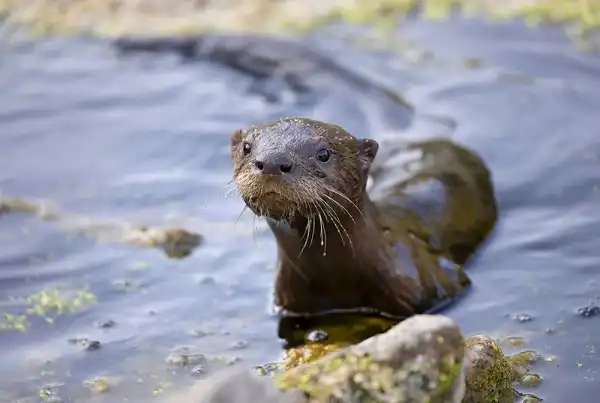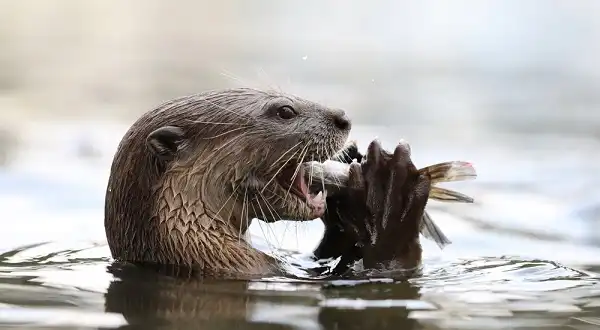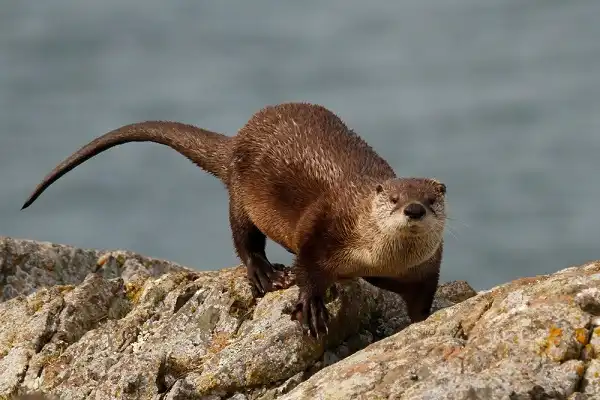From a distance, the river otter looks like it’s having way too much fun. It bounds along playfully in search of its next adventure and, somehow, always manages to make the journey look effortless. But when you get up close to these delightful aquatic mammals—which can be found in rivers, lakes, estuaries, and coastal waterways around the world—it’s clear that their underwater acrobatics are just one part of an incredibly complex lifestyle. From what they eat to where they sleep and beyond; there is so much more to learn about this unique species! Let’s dive into everything else there is to know about the wonderful river otter.

River Otter Description
River otters are carnivorous mammals that live mainly in and along rivers, streams, ponds, lakes, and estuaries. They have long, slim bodies with short legs and webbed feet for swimming. Their coats are typically thick and glossy, ranging from light brown to almost black in color. River otters are intelligent animals that use their powerful sense of smell to detect prey. River otters are semi-aquatic carnivorous mammals that belong to the Lutra genus in the Mustelidae family surface. They usually have long, slender bodies with short legs and a flattened tail. Their fur is dense, water-resistant,! and brownish or black in color.
River Otter Habitat
River otters have a wide variety of habitats and can be found in many parts of the world. They live mainly in rivers, streams, ponds, lakes, estuaries, and coastal waterways and can thrive in both fresh and salt water. River otters are highly adaptable animals that can live in a range of different habitats from wooded areas to marshes to urban environments. In terms of their preferred habitat, river otters like areas with slow-moving water that is deep enough for swimming. They also require access to land so they can easily come out of the water and rest. River otters require areas of dens that are secluded and inaccessible to predators in order to sleep, mate, or give birth. These dens can be made from burrows dug into the ground or natural crevices along the banks of a body of water. With their adaptable nature and wide range of habitats, river otters have been able to survive and remain relatively common in many parts of the world. However, they are still vulnerable to changes in their environment, so it is important that we protect their habitats and take steps to ensure their continued survival.
River Otter Diet
River otters have a varied diet that consists primarily of fish and other aquatic animals such as amphibians, mollusks, crustaceans, small mammals, and insects. They are opportunistic hunters who use their powerful sense of smell to detect prey in the water around them. To capture their prey, they will lurk in wait at the edges of rivers or lakes and then quickly grab whatever is floating by with surprising speed! In addition to these animals, river otters also feed on plant matter like roots and stems. They will also eat fruit when it is available and sometimes even small reptiles or birds.
Their diet varies depending on what is available in their local environment but can include things like salmon, trout, eels, mussels, frogs, crayfish, snails, crabs, clams, mice, or voles. Overall river otters have a diverse diet which helps them thrive in both fresh and saltwater environments. Due to their adaptable nature and wide range of habitats, they remain relatively common in many parts of the world despite changes in their environment which could threaten their survival. With proper protection and conservation efforts, we can ensure that these playful creatures continue to inhabit our rivers and waterways for years to come!

River Otter Size
River otters are typically between 2 and 4 feet in length and usually weigh between 10 to 15 pounds on average. While the size of an adult river otter varies based on species, all otters are relatively small animals with short legs, long, slender bodies, and a flattened tail. They have long, slender bodies with short legs and flattened tails that help their fur move through the water quickly. Their fur is dense, water-resistant, and usually brown or black in color typically. Brown river otters use their webbed feet, paddle-fishlike tail, and eyes located on the sides of- their head to help them efficiently navigate underwater. They also lack possess an inner layer of fur that keeps them warm while swimming in cold waters.
River Otter Lifespan
River otters have a relatively long lifespan for their size, with some living up to 20 years in the wild. In captivity, their lifespans may be even longer, up to 30 years or more. The lifespan of a river otter is largely determined by factors such as food availability, water quality, and exposure to predators. In the wild, river otters reach sexual maturity at around 2 years old and typically live for eight to nine years on average. As mentioned above, some individual river otters have lived much longer than this – up to 20 years – meaning that they can live almost twice as long as other small mammals such as rabbits and mice. The average lifespan of a river to lifespan is influenced by several factors, such as their often habitat, size related, and health.
River otters inhabit areas environment with abundant food sources. Secure shelters Poor tend to water to be healthier quality and longer due-lived than those living in less suitable environments. Similarly, larger river otters tend to pollutants live with smaller ones due to their better ability to access food or sources and mates. In addition to these external factors, rivers or decreases also face dangers from predators such as wolves, foxes, coy lifemates, bears, and birds of prey. Even though these animals rarely expectancy act aggressively towards otters they often compete with them for food or even try to hunt them down if they find them vulnerable or weak enough.
River Otter Behavior
River otters are highly social animals and have a wide variety of behaviors that they use to communicate with their families and other otters in the area. They are very vocal creatures and can be heard making noises like whistles, chirps, yips, and howls. They also use body language to express themselves such as gaping their mouths, slapping the water with their tails or paws, and arching their backs. River otters are active during both day and night though they are usually most active at the time of dusk or dawn. During the day they spend much of their time playing, sleeping, grooming, foraging for food, and even digging burrows in river banks.
In addition to being skilled hunters river otters also have a unique set of skills that make them excellent swimmers. First off they have webbed feet which act like paddles to propel them through the water quickly. Secondly, they possess an inner layer of fur which helps keep them warm while swimming in cold waters. Lastly, they have eyes located on either side of their head allowing them to see equally well underwater as out. Finally, river otters are known for engaging in playful activities such as chasing each other around in circles or sliding down muddy banks into bodies of water together – quite often with an audience!

River Otter Speed
River otters are known for their impressive speed and agility both in and out of the water. In water, they can reach speeds up to 7 mph, which is faster than a person’s fastest sprinting speed! This allows them to easily catch their prey as well as avoid predators or other potential dangers. Out of the water, river otters can move even quicker – reaching top speeds of 11 mph when running on land. This fast-paced life isn’t all about hunting though: It also enables river otters to explore their habitat in search of new food sources or dens to use during certain times of the year. They also use this speed and agility for playing with each other or just enjoying the freedom of movement that comes with such swiftness.
River Otter Hunting
River otters are excellent hunters, employing a variety of strategies to catch their prey. They typically hunt alone or in small groups, using their superior swimming and diving skills to chase down fish or other aquatic animals. River otters have also been known to ambush unsuspecting prey by lurking in hiding spots along the river banks before striking with lightning speed when the opportunity presents itself! When hunting larger prey such as ducks or muskrats, river otters use a combination of stealth and brute force – sneaking up on their target before using their powerful jaws and claws to hold it down while they consume it. They may also employ ambush tactics and utilize the element of surprise while hunting. River otters also rely on their highly developed sense of sight, hearing, smell, and taste to locate potential meals. This allows them to zero in on food sources even when visibility is poor due to murky water or darkness. They can even detect movement in water from great distances and will often track prey by following its scent trail through waterways.
River Otter Reproduction
River otters reproduce sexually and typically mate in the springtime. During courtship, males will pursue females with vocalizations, swimming behaviors, and even presents such as stones or fish. After mating takes place, gestation lasts for approximately 60 to 63 days before the female gives birth to a litter of up to 5 offspring. The young are born blind and deaf and lack fur. They rely on their mother for warmth and nourishment for the first few weeks until they are able to regulate their body temperature and swim on their own.
The mother will also help teach them how to hunt and fend for themselves as they grow older. Young river otters become independent after 6 months which is usually when they start accompanying their mother on hunting trips or other activities outside of the den site. Overall, river otters have complex reproductive strategies that enable them to thrive in spite of challenging environmental conditions such as harsh winters or limited food sources due to competition among species. These techniques ensure that future generations continue to benefit from these playful creatures’ presence!

Conclusion
River otters are fascinating animals that inhabit both land and sea. They possess impressive speed and agility, allowing them to swim quickly underwater or run fast on land. In addition to being excellent swimmers, river otters are also accomplished hunters – using their senses of smell, sight, hearing, and taste as well as ambush tactics and tools to locate prey. Overall, the combination of their physical abilities as well as their intelligence enables river otters to thrive in a variety of environments across the globe!
Frequently Asked Question


